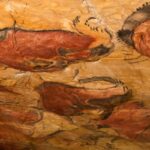We explain what the Neolithic is and what are its general characteristics. In addition, how was the art and architecture of the Neolithic.

What is the Neolithic?
The Neolithic is The last period of prehistory. Integrates the stone age, together with the Paleolithic and Mesolithic periods.
The Neolithic word comes from the Greek neowhich means “new” and Lithoswhich means “stone”, and refers to The new stone tools manufacturing techniques that characterize this period.
The periods included within the stone age are linked to the historical development of each culture or civilization, and its temporal location may vary according to the appearance of certain technical or cultural features of each society. The Neolithic period It is characterized by the development of agriculture and the appearance of sedentary lifestyle.
The beginning of the Neolithic period can be temporarily located between 8000 a. C. and 4500 a. C., depending on the historical development of the society in question. The end of the period is directly linked to the appearance of deed and centralized political organizations that begin the old age of traditional periodization, between 3000 a. C. and 500 a. C., according to the region.
In the area of the fertile growing (Mediterranean lift, Asian and Egypt Mesopotamia), the transformations that give rise to the Neolithic period date approximately 8000 BC. C.; In India, Balkan Europe, Southeast Asia and Mesoamerica, date from 7000 a. C.; In China, from 6000 a. C. and in South America, from 4500 a. C.

See also: Primitive Man
Neolithic characteristics
The main element that defines the Neolithic period is the transition made by some human populations of a subsistence economy to a productive economy. This process implied the following characteristic:
- Emergence of agriculture
- Domestication of cattle
- Development of sedentary lifestyle
- Population growth
- Metallurgy discovery
- Division and differentiation of work
- Surplus production
- Social hierarchy
Economy of the Neolithic Period
During the Neolithic period, the economy of different human societies went from being a subsistence economy to a productive economy. This means that human groups They began to intervene in the natural cycles of plants and animals for their best use. Two fundamental practices for the life of the human being were born: agriculture and livestock.
The origin of livestock is linked to controlled hunting. In principle, the groups of hunter-gatherers preserved the animals that were in reproductive age, to ensure the future food. Then they began to capture animals and lock them in pensto have food available in case of shortage. Later, they reproduced the herds that had captives, through the selection of the smallest and docile specimens.
Agriculture was developed from the collection. Thanks to the observation of plant growth, some human groups selected seeds, plant them and waited for their growth. At first, this was practiced itinerant and in spaces for planting generated from the burning and logging of forested areas. The low performance of these lands led these societies to look for spaces more suitable for planting and harvesting. In this way, the first fields of crop were created permanently.
In the areas where the neolitization process was given, different crops were developed:
- In the Near East, cereals (wheat, barley and millet), linen, beans, vid and olive tree were grown.
- In China, the most common crops were rice, cotton, millet and soybeans.
- In Mesoamerica, pumpkin, chiles, corn, avocado and beans were developed.
- In the central Andes, the most important crops were potatoes, cassava, pepper, pumpkin, beans, lentils and cotton.
Way of life in the Neolithic period

Gradually, some groups of hunter-gatherers were permanently established in fixed spaces and abandoning the nomadic way of life. Traditionally, archaeologists considered that the sedentary way of life was a direct consequence of the development of agriculture and livestock. However, following various archaeological findings, many specialists argue that sedentary lifestyle was a process that began before the consolidation of food production economies.
The oldest archaeological evidence of semi -permanent settlements date from between 12000 and 10000 a. C. It is believed that, due to the abundance of resources for hunting, fishing and cereal collection, Some nomadic groups were establishing camps for increasingly prolonged periods. They developed systems for storing food and built huts of round plant, semi -soured, with roofs of branches, reeds and straws.
Later, with the development of crops and the creation of animal herds, the seasonal nature of agriculture and livestock care, led to establishment of a sedentary life permanently. These first villages, called villages, were established in fertile places, with access to water and pastures.
Social organization in the Neolithic period
The sedentary life in villages led to the development of a different social organization than the one that prevailed among the groups of hunter-gatherers. The villages were made up of several families had their animal herds and their cultivation fields. Families cooperated to carry out agricultural tasks, the defense of the town, the search for materials and the construction of housing and fortifications.
Then, the new economic activities and sedentary life gave rise to the differentiation of tasks and, consequently, to a Division of labor by trades or specialties. The specialists were skilled artisans in the manufacture of the different types of stone, ceramics, fabrics and metal tools.
These first villages were of scarce population. However, as food production increased, it was possible to store surpluses. The greatest availability of food led to significant population growth.
With population growth and homework specialization The first cities appeared. Urban development brought the hierarchy of society. This means that in cities, social differences were developed between people according to the tasks they performed. The specialists, such as merchants and artisans, occupied a position superior to that of the peasants, who produced food for the entire community.
In addition, the first groups that were dedicated exclusively to political and religious tasks appeared, and were located at the top of the social scale. The priests directed the cult and sent the construction of temples and the delivery of offerings to the gods.
Officials were responsible for political organization of the city, the administration of goods and the management of the surpluses produced.
Religion in the Neolithic period

The societies of the Neolithic divinized the forces of nature, especially those elements that affected the development of agriculture and livestock. The sun and rain began to have a central place in religious rites and ceremonies.
In addition, they created anthropomorphic sculptures (of human appearance) with which they represented their ancestors or different forces they adored, such as fertility.
During this period, The burial of the dead became a social distinctive Among the rituals of the different populations. According to different beliefs, the body was buried in different ways; For example, on the ground surrounded by objects of everyday life, or within baskets or ceramic polls.
With the appearance of cities, The cult began to be directed by priests. His role was to mediate between men and divinities, and therefore they received taxes and offerings from the entire population.
This central role led the priests to obtain a prestigious social position that differentiated them from the rest of society. From this place, they became leaders of their community and took care of the direction of everyday affairs.
NEOLYTIC PERIOD ART

In the cave paintings of the Neolithic period figurative images of animals, human beings, symbols were represented and different scenes of everyday life, painted with monochromatic tones.
In addition, in the different megalithic constructions engraved on the stones. The ceramics were painted with geometric motifs.
Neolithic architecture

The different populations of the Neolithic They used stone blocks to lift giant constructionsto which archaeologists call megalithic or megalith monuments.
Specialists believe that these constructions were used as sacred spaces or sanctuaries. On many occasions, these spaces were also used as cemeteries. In addition, it is believed that they could also be used as brands through which the different communities claimed the territory and reinforced their group identity.
There were different types of megaliths:
- Slums. A dolmen is a construction formed by several stone slabs, nailed to the stone vertically, with a roof slab supported on them in horizontal position. The set forms a camera and, on many occasions, it is surrounded by mounds or stones that cover the pile and thus form an artificial hill.
- Menhires. A menhir is a little worked megalith. It is the artificial location of a large stone in a given space. Some menhires present engravings, others are sculpted with some particular form. Its size can vary from small rocks located in a particular way, to giant monoliths more than 10 meters high.
- Cromech. Cromech are megaliths formed by stones stuck in the ground, in the form of a circle or an ellipse. The stones are usually large and close land.
Handicrafts and materials of the Neolithic period

During the Neolithic period, the different populations perfected stone work techniques and created work techniques for new materials, such as ceramics and metals.
- Polished stone. The polishing technique involved rubbing the stone until it shapes and removes edge. In this way, more effective weapons and new tools were achieved. Linked to the development of agriculture, mortars were created to grind the grains, children to harvest crops and hoes to move the earth.
- Ceramics. The ceramic modeling method consisted of stacking clay rolls until it reached the desired height, then smooth them and shape their hands. The pieces were allowed to dry and then cooked in a high temperature oven. Finally, they were decorated with geometric motifs, engraved or painted.
- Metallurgy. Towards 4000 a. C., the foundry of metals was invented for the first time. The foundry was carried out in clay containers that allowed metal to high temperatures. Then, the metal turned into moles of earth or stone that had the shape of the object. The first metals that were worked were gold, silver and copper, and were used to make jewels, tools, ornaments and weapons.
Archaeological sites of the Neolithic period

Some of the characteristic archaeological sites of the Neolithic period are:
- Jerichoin the current Palestine, it is the oldest walled settlement that is known. Towards 8000 a. C., was formed by housing and barrieros of adobe and stone, and surrounded by a wall 800 meters long and six meters high.
- Çatalhöyükin the current Türkiye, it is one of the best preserved settlements of the Neolithic period. The specialists still discuss whether some of the constructions had a ritual public use or if, on the other hand, it was in their entire private homes. It is believed that this settlement came to house more than 10,000 people, and was inhabited between 8000 and 5700 a. C.
- ERIDU, In the current Iraq, it was a city founded towards 5400 a. C. Some specialists consider that it was the urban center with the oldest political and social hierarchy. On the site, the remains of a sanctuary on which more than 17 temples were built over the centuries have been found. The last temple dates from 3800 a. C., and adopted the stepped pyramid shape.
- Göbekli Tepein Türkiye, it is the site where one of the oldest sanctuaries of the Neolithic period is located. It is believed that it dates from 9600 a. C., and that, for some unknown reason, was entirely abandoned towards 8000 a. C., after being deliberately covered with land. His discovery in 1994, revolutionized studies on the period, since it is a sedentary feature of the development of agriculture and livestock in the area.
- The dolmens of Sorginetxe and of Aizkomendiin the current Spain, they are megalithic monuments of the end of the Neolithic period, which were built as ritual spaces and territorial claim brands by local communities.
- StonehengeIn England, it is one of the best known Cromlech megaliths. It is believed that the construction was carried out around 2500 a. C., although previously the place was used as a cemetery. The site was attached along a 3 -kilometer road to a settlement, also built in a circular manner, in which there were about 300 homes.

Continue with:
References
- Almudena, HG (1993). The neolitization process, theoretical perspectives for the study of the Neolithic. Editions University of Salamanca.
- Cauvin, J. (1992). Neolitization process in the next East. Treballs d’Arqueologia, 2, pp. 1-16.
- Eiraa, JJ (2000). The Neolithic. In Notions of general prehistory. Ariel History.
- Fernández Martínez, VM (2007). Prehistory. The long path of humanity. Editorial Alliance.
- Fernández Vega, AM, Cabrera Valdes, V. and Muñoz Amilibia, AM (2008). Prehistory. National University of Distance Education.





